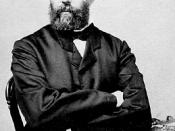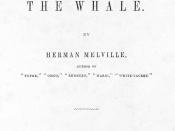"...I came here to hunt whales, not my commander's vengeance. How many barrels will thy vengeance yield thee even if though gettest it, Captain Ahab?" This quote from Moby Dick is an example of the use of allegory to symbolize the stupidity of vengeance. Several of the selections from the anti-transcendentalist period use allegory to symbolize ideas from the movement, such the vengeance in Moby Dick by Herman Melville, the greed in Nathaniel Hawthorne's "Dr. Heidegger's Experiment," and the evil in "The Raven" by Edgar Allen Poe.
The first selection that uses allegory is Moby Dick by Herman Melville. Captain Ahab symbolizes the danger in becoming overly determined. Captain Ahab will not let in to his need for vengeance. For example, Captain Ahab says "And this is what ye have shipped for, men! To chase that white whale on both sides of land, and over all sides of earth, till he spouts black blood and rolls fin out."
In the end, his determination leads to the deaths of almost his entire crew. Another symbol is the captain of the other ship that Ahab meets on the ocean. This captain symbolizes rationalism as he tries to convince Ahab that his quest is foolish and dangerous.
Another work containing symbols is "Dr. Heidegger's Experiment" by Nathaniel Hawthorne. This selection symbolizes the greed of humans. Dr. Heidegger's guests in the story are not happy with only one glass. They must have the whole pitcher. This story also shows how many people never learn from mistakes. However, the wise Dr. Heidegger learns his lesson as can be seen by this quote: "... if the fountain gushed at my very doorstep, I would not stoop to bathe my lips in it--no, though its delirium were years instead of moments. Such...


